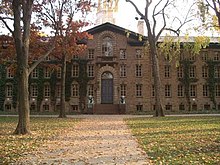This is a temporary subpage where I'm experimenting with revisions of the Princeton University entry with User:ExplorerCDT. If you're interested leave a message on my talk page!
| Princeton University Coat of Arms | |
| Motto | Dei sub numine viget (Under God's power she flourishes) |
|---|---|
| Type | Private |
| Established | 1746 |
| Endowment | US $11.3 billion[1] |
| President | Shirley M. Tilghman |
| Undergraduates | 4,635 |
| Postgraduates | 1,975 |
| Location | , , |
| Campus | Suburban, 600 acres (2.4 km²) (Princeton Borough and Township) |
| Athletics | 38 sports teams |
| Nickname | Tigers 40px| |
| Website | www.princeton.edu |
Princeton University is a coeducational private university located in Princeton, New Jersey.
According to the university, it is the fourth-oldest institution of higher education in the U.S.[2] and is one of the eight Ivy League universities. Originally founded at Elizabeth, New Jersey in 1746 as the College of New Jersey, it was relocated to Princeton in 1756 and renamed Princeton University in 1896.
Princeton has traditionally focused on undergraduate education and academic research, though in recent decades it has also increased its focus on graduate education. Its library holds over six million volumes.
Originally a Presbyterian institution, Princeton is now non-sectarian and makes no religious demands on its students.[3]The university has ties with the Institute for Advanced Study, Princeton Theological Seminary and the Westminster Choir College of Rider University.[4]
History
The College of New Jersey
Established by the “New Light" Presbyterians, Princeton was originally intended to train Presbyterian ministers. The college opened at Elizabeth, New Jersey, under the presidency of Jonathan Dickinson as the College of New Jersey, after Jonathan Belcher declined a proposal to have it named after him. Its second president was Aaron Burr, Sr.; the third was Jonathan Edwards. It was in 1756 that the college moved to Princeton, New Jersey.
From the time of the move to Princeton in 1756 until the construction of Sir Henry Rutgers Hall in 1803, the University's sole building was Nassau Hall, named for William III of England of the House of Orange-Nassau. The University also got one of its colors, orange, from William III. During the American Revolution, Princeton was occupied by both sides, and the college's buildings were heavily damaged. The Battle of Princeton, fought in a nearby field in January of 1777, proved to be a decisive victory for General George Washington and his troops. Two of Princeton's leading citizens signed the Declaration of Independence, and during the summer of 1783, the Continental Congress met in Nassau Hall, making Princeton the country's capital for four months. The much-abused landmark survived bombardment with cannonballs in the Revolutionary War when General Washington struggled to wrest the building from British control, as well as later fires that left only its walls standing 1802 and 1855. Rebuilt by Joseph Henry Latrobe, John Notman, and John Witherspoon, the modern Nassau Hall has been much revised and expanded from the Robert Smith designed original. Over the centuries, its role shifted from an all-purpose building, comprising office, dormitory, library, and classroom space, to classrooms only, to its present role as the administrative center of the university. Originally, the sculptures in front of the building were lions, as a gift in 1879. These were later replaced with tigers in 1911.[5]
The Princeton Theological Seminary was separated from Princeton in 1812, since the Presbyterians wanted their ministers to have more theological training, while the faculty and students would have been content with less. This reduced the student body and the external support for Princeton for some time. The two institutions currently enjoy a close relationship based on common history and shared resources.

The university was becoming an obscure backwater when President [[] took office in 1868. During his two decades in power, he overhauled the curriculum, oversaw an expansion of inquiry into the sciences, and supervised the addition of a number of buildings in the High Victorian Gothic style to the campus.[6] McCosh Hall is named in his honor.
Princeton
Organization
Add information about governance structure, rougly like the "Organization" section that Cornell has.
Undergraduate Program
Academics
are fun
Academic Calendar
Admissions
Financial Aid
Residential Colleges
Whitman College
Undergraduate Student Life
Eating Clubs
Graduate Program
We may need to get some more content in for this, but it probably needs/deserves a section.
Athletics
Library System
I'm not convinced this is a topic, but is probably too much scattered around the article to ignore it.
Campus & Landmarks
University Chapel
Nassau Hall
Cannon Green
McCarter Theater
Art Museum
Alumni Relations
Reunions
There are whole articles on this and it's not really covered in the main article. A lot of "traditions" can go here.
References
See Also
- List of Princeton University people - already there, no need for the "Lists of Princeton people" section!
- Princeton University in Fiction - from the "In Fiction" section